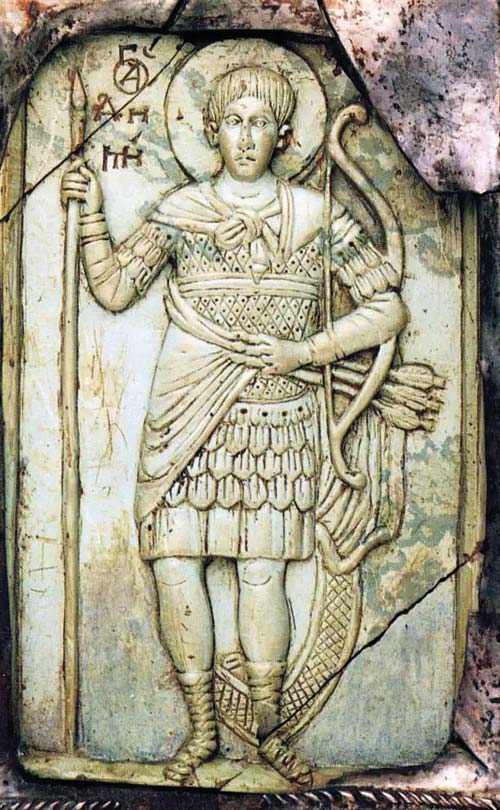THE ROLE OF PHYSICAL CULTURE AND SPORTS IN THE TRAINING OF MASS CONSCRIPTS IN THE BYZANTINE EMPIRE
DOI:
https://doi.org/10.24852/2587-6112.2020.6.165.178Keywords:
Byzantium, physical culture, sports, archery, wrestling, fistfight, pankration, petropolemos, ampraAbstract
The paper examines the role of physical culture and sports in the process of training Byzantine warriors in the Early and Middle Byzantine periods. Various types of sports games and competitions are considered - both for children and youth, by means of which pre-conscription training was provided, as well as military sports exercises and competitions in the Byzantine army. It is concluded that despite the elimination of the ancient system of palaestra and gymnasia, the mass physical training of Byzantine boys, adolescents and youth of military age in Byzantium was a profound and logical system aimed at the development of strong, courageous and tempered warriors. Its fundamental difference from the ancient period was that the primary physical education of children and adolescents was entrusted not to the state or community, but to the family. The task of the community was to create conditions for holding sports competitions, whereas the state was involved in the physical education of young men after they were included in military lists during maneuvers and military campaigns.
References
Anonimnyi voinskii trakat “Kak vyderzhat’ osadu” (Anonymous Military Treatise “How to Withstand a Siege”) In Khapaev, V. V. 2016. Vizantiiskii Kherson na rubezhe tysiacheletii: vtoraia polovina X – pervaia polovina XI v. (Byzantine Kherson at the Turn of the Millennia: Second Half of 10th - First Half of 11th cc.). Simferopol: “Nizhniaia Orianda” Publ., 509–538 (in Russian).
Armuris (Armouris) In Freiberg, L. A. (ed.). Pamiatniki Vizantiiskoi literatury IX – XV vekov (Monuments of Byzantine Literature of the 9th-15th Centuries). Moscow: “Nauka” Publ., 158–160 (in Russian).
Digenis Akrit (Digenes Akritas). 1960. Moscow: Academy of Sciences of the USSR Publ. (in Russian).
D’yakonov, A. P. 1945. In Kosminskii, E. A. (ed.). Vizantiiski sbornik (Byzantine Collection). Moscow; Leningrad: Academy of Sciences of the USSR, 144–227 (in Russian).
Kubratov, G. L. 1962. Rannevizantiiskii gorod (Antiokhiia v IV veke) (Early Byzantine Town (Antioch in the 4th Century)). Leningrad: Leningrad State University (in Russian).
Lazarev, V. N. 1986. Istoriia vizantiiskoi zhivopisi (History of Byzantine Graphic Art). Moscow: “Iskusstvo” Publ. (in Russian).
Levchenko, M. V. 1947. In Vizantiyskiy Vremennik (Byzantine Yearbook) 1, 164–183 (in Russian).
Libanius. 1914. Rechi (Speeches) 1. Kazan: Typography of the Imperial University (in Russian).
Libanius. 1916. Rechi (Speeches) 2. Kazan: Typography of the Imperial University (in Russian).
Lyuttvak, E. N. 2010. Strategiia Vizantiiskoi imperii (The Grand Strategy of the Byzantine Empire). Moscow: University Of Dmitry Pozharsky (in Russian).
Psell, M. 1978. Khronografi ia (Chronography). Lyubarskii, Ya. N. (transl.). Moscow: “Nauka” Publ. (in Russian).
Nicephorus Gregoras. 2013. Istoriia romeev (History of the Romei) 1. Saint Petersburg: “Svoe izdatel’stvo” Publ. (in Russian).
Kuchma, V. V. (ed.). 2007. O strategii. Vizantijskii voennyi traktat VI veka (On Strategy. Byzantine Military Treatise of the 6th century). Saint Petersburg: “Aleteiia” Publ. (in Russian).
Theophanes Continuatus. 1992. Zhizneopisaniia vizantiiskikh tsarei (Biographies of Byzantine Kings). Moscow: “Nauka” Publ. (in Russian).
Nefyodkin, A. K. 2005. (ed.).Strategika Nikifona II Foki (Strategica by Nikephoros II Phokas). Saint Petersburg: “Aleteiia” Publ. (in Russian).
Kuchma, V. V. (ed.). 2004. Stratekikon Mavrikiia (Strategikon of Maurice). Saint Petersburg: “Aleteiia” Publ. (in Russian).
Kuchma, V. V. (ed.). 2012. Taktika L’va (Lion’s Tactics). Saint Petersburg: “Aleteiia” Publ. (in Russian).
Titmar Merzenburgskii. 2009. Khronika ( Chronicle). Moscow: “Russkaia panorama” Publ. (in Russian).
Uspenskii, F. I. 1894. In Vizantiyskiy Vremennik (Byzantine Yearbook) 1,. 1–16 (in Russian).
Feofi lakt Simokatta, 1957. Istoriia (History). Moscow: Academy of Sciences of the USSR (in Russian).
Khapaev, V. V. 2015. In Gvozdeva, T. B. (ed.). Traditsii antichnogo olimpizma v mirovoi kul'ture: ot drevnosti do nashikh dnei (Traditions of Ancient Olympism in World Culture: from Antiquity to the Present Day). Moscow: Maxim Gorky Literature Institute Publ., 149–164 (in Russian).
Khomutskii, V. 2016. Vizantiiskoe oruzhie i dospekhi na izobrazitel'nykh istochnikakh (Byzantine Weapons and Armor in Graphic Sources) Available at: https://historicaldis.ru/blog/43826515054/Vizantiyskoe-oruzhiei-dospehi-na-izobrazitelnyih-istochnikah utm_referrer=mirtesen.ru&page=2 Accessed 09.11.2020)
Chekalova, A. A. 1982. In Udaltsova, Z. V. (ed.). Vizantiyskie ocherki (Bizantium essays). Moscow: “Nauka” Publ., 37–53.
Yasheva, T., Denisova, E., Ginkut, N., Zalesskaya, V., Zhuravlev, D. 2011. Nasledie vizantiiskogo Khersona (The Legacy of Byzantine Kherson). Sevastopol, Austin: “Telrskop” Publ., Texas University (in Russian).
Ariantzi, D. 2009. Aspekte der Kindheit in Byzanz vom 6. bis 11. Jahrhundert im Spiegel hagiographischer Quellen. Wien: Dissertation (in German).
Carr, Т., Sheppard, K., Welch, А. 2010. Sport During the Byzantine Era. Byzantium as a Context for Social Sciences Research, 1–15.
Crowther, N. 1996. In International Journal of the History of Sport. 3, 445–458.
Giatsis, S. G. 2007. In Erytheia. 28, 15–40.
Giatsis, S. G. 2000. In International Journal of the History of Sport,17:1, 36–68.
Guilland, R. 1965. In Byzantinoslavica. 26, 1–33 (in English).
Guttmann, A.1981. In Journal Of Sport History 8(2), 16–17 (in English).
Ioannes Scylitzes. Synopsis historiarum // Manuscrito del siglo XII / Biblioteca Nacional de España. 234 [i.e. 233].
Oxford Dictionary of Byzantium. Oxford: Oxford University Press..
Schmitt, J. 1904. The chronicle of Morea (To chronikon tou Moreos): a history in political verse, relating to the establishment of feudalism in Greece by the Franks in the thirteenth century. London: Methuen.
Schrodt, B. 1981. In Journal Of Sport History. 8(3), 51–52 (in English).
Wolińska, T. 2011. Constantinopolitan Charioteers and Their Supporters. Łódź: Studia Ceranea 1, 127–142.
Κουκουλές Φ. 1948. Βυζαντινων βιος και πολιτισμος. Τ. A. 1. Σχολεία. Παίδων ανατροφή. Παίγνια. Αθηναις, (in Greek).
Κουκουλές Φ. 1949. Βυζαντινων βιος και πολιτισμος. Τ. Γ. Ο ιπποδρομος και οι ιπποδρομικοι αγωνες. Οι αγωνες και τα αγωνισματα. Οι βυζαντινοι αιχμαλωτοι. Η διαπομπευσις οι κλεπται και αι φυλακαι. Τα λαϊκα θεαματα και αι λαϊκαι διασκεδασεις αι εμπορικαι πανηγυρεις. Αι εριδες και αι υβρεις αι αραι, αι ευχαι και οι ορκοι. Αθηναις (in Greek).

Downloads
Published
How to Cite
Issue
Section
License
Copyright (c) 2020 V. V. Khapaev, A. M. Glushich

This work is licensed under a Creative Commons Attribution-NonCommercial 4.0 International License.







